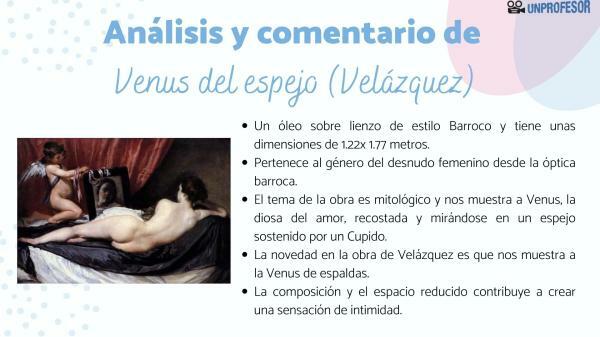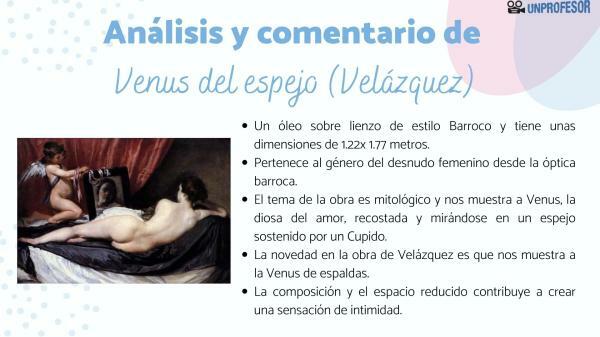Venus from the mirror by VELÁZQUEZ

In the 17th century, Spain was immersed in a deep crisis, losing its hegemony in Europe, suffering from epidemics and famines, and the religious struggles of the Counter-Reformation. At this time, some of the great geniuses of painting emerged, such as Velazquez and Murillo, integrating the call Spanish Golden Age.
on the job mirror venus of Velazquez It is an original work due to the sensuality it captures and how it shows us the face of the goddess reflected in a mirror, linking eroticism and beauty. In this lesson from unPROFESOR.com we offer you a complete commentary and analysis of the mirror venus.
Index
- Technical analysis of the Venus of the mirror
- Meaning of the Venus of the mirror
- Commentary of the Venus of the mirror
- Who is the Venus in the mirror?
Technical analysis of the Venus of the mirror.
This work titled mirror venus was painted by Diego VelazquezAlthough it is not clear what the date of completion of the work is. It is suspected that he was executed between the years
1648 and 1650, on the second trip to Madrid. Although it is also thought that it could have been carried out at the same time as Spinners, opening a third theory that suggests that it could be dated shortly before the painter's second trip to Italy.An oil on canvas Baroque style and has dimensions of 1.22x 1.77 meters. It is located in the National Gallery in London and belongs to the genre of the female nude from the baroque perspective, that is, with a predominance of curved lines and diagonals within a balance, an excellent use of color and soft and subtle lights.
Theme of the mirror venus
The theme of the work is mythological and shows us Venus, the goddess of love, reclining and looking at herself in a mirror held by a Cupid. A subject that already had precedents in the works of painters of the Venetian school such as Titian, Veronese, Rubens, Tintoretto or Giorgione.
The novelty in the work of Velázquez is that he shows us Venus from behind, reclining on a gray taffeta and white sheets. Cupid holds a mirror with a dark frame and decorated with blue ribbons. The goddess has in front of her a crimson curtain that contrasts with her white skin and dark hair. She looks at herself in the mirror, enthralled or pleased with what she sees. Little Cupid also watches her, absorbed in her face.
Composition of the work
The composition is marked by a series of curves and a marked diagonal by the leg of Venus. The sinuosities are also found in the sheets and in the gray taffeta coverlet, bringing great sensuality to the work.
Another diagonal line goes from the gaze of the goddess towards Cupid and the mirror marking an ascending line towards the red background. This composition and the reduced space in which the scene unfolds contributes to creating a feeling of intimacy.
technique used
As regards the technique, at this time the painter has reached his maturity. The color predominates over the line, Velázquez resorting to warm tones and color contrasts that allow to highlight the pearly color of the skin of the Venus against the dark gray of the taffeta or the red of the curtains, also including a great variety of shades. Velázquez resorts to loose and clear brushstrokes, little impasto, and with a use of light that allows to create a warm and intimate atmosphere.
Perspective is area, shallow and it takes place in various depth planes that manage to unite the most important areas of the scene: the bed, the goddess, the mirror, Cupid and the curtain.

Meaning of the Venus of the mirror.
This work by Velázquez has a complex meaning, being considered an exceptional painting as it exceeds its time and shows a pre-impressionist brushwork, close to the currents of the late 19th century and an unconventional representation of Venus by showing it from behind. By showing his behind, Velázquez connects with the Baroque tradition, with painters such as rubens.
Between the meanings of the mirror venus stand out:
- Velazquez she manages to humanize mythology and it presents us with the female body of the goddess in a naturalistic way and with great beauty both in her face and in her body.
- The fact that he appears looking at himself in a mirror also introduces us to another of the baroque themes, vanity. The goddess is humanized by enjoying herself in the contemplation of her face and puffing up before her beauty.
- Another meaning is how love, represented in the work by Cupid, he surrenders to the beauty and eroticism that the goddess exudes.
- but the mirror too introduces the viewer when we meet the gaze of the goddess on its surface. Thus, the painter and the spectator reflect on the same plane about love, beauty and eroticism, this being one of the few nudes made during the Baroque in Spain.

Commentary of the Venus of the Mirror.
As we have already pointed out, the mirror venus of Velázquez is a truly unique work since in his time mythological painting was really a minority compared to the huge production of religious themes of the time. His inspiration was a canvas of Titian, lost during the 11th century, and which formed part of the royal collections of the Spanish court. This canvas was copied by Rubens, being conserved in the National Gallery of Washington.
The myth of Venus was one of the sources of inspiration for the painting of more sensual content. Velázquez is not only inspired by the Venus in the Mirror by Rubens and Titian, he also does it in his style and offers a natural vision of the myth as in Spinners, providing more closeness and sensuality. Thus, the goddess does not seem so unattainable and shows her as a real woman. The myth is humanized, but Velázquez follows the baroque taste and presents us with the goddess in an intimate scene, in her boudoir and showing us a moment of coquetry. Venus rejoices at her beauty and her Love, seduced by her charm, surrenders to her.
Velázquez represents Venus, goddess of love, desire, beauty and fertility, but without resorting to the classical attributes with which she used to be. Thus, objects such as roses, jewels and myrtle are missing and, in addition, she is presented from behind, hinting more than showing and allowing us to admire the white, soft and delicate tone of the goddess's skin.
With it appears a winged cupid, with no other attribute than her wings, leaving aside her bow and arrows and with a ribbon that seems to symbolize the union between the goddess and the child. The faces of both are outlined with colored spots and in which Cupid's adoration for Venus is shown and how he surrenders to her.
The mirror is an element that also draws our attention and that it constitutes a resource used by Velázquez to introduce the viewer into the work when the goddess looks at us and makes us participate in that moment of self-satisfaction. The face of the goddess is painted by Velázquez in the style of the Dutch masters, blurring the image and thus resorting to a resource also used by previous painters such as Quentin Massys or the Van Eyck brothers. The imprint of Titian's influence is evident in the treatment of the folds of the fabrics.
Added to the influences received by Velázquez are those left by the painter in other authors. After Venus in the mirror, later painters will carry out nudes without so many limitations and directly addressing the nude of a woman without having to resort to a myth. So, both Goya and Manet will show the nude of a woman. In the case of the first we have its naked maja and, in Manet's, olympia, a prostitute.

Who is the Venus in the mirror.
In the case of Velázquez, a new question arises: Who was the Venus in the mirror? Was she Velázquez's lover? This brunette Venus, until then she used to be represented as blonde, presents many questions without a clear resolution. Thus, the first documentary reference to him dates from 1651, the year in which he appears in an inventory of the possessions of the Marqués del Carpio, great-nephew of, Conde Duque de Olivares, one of the patrons of Velazquez.
Be that as it may, in recent years it is considered that this work was carried out during his second and last trip to Italy, place where the painter felt free enough to paint a nude of these characteristics.
- The use of models for the realization of female nudes was not well considered, something that led to be inspired or say they were inspired by fictional ladies and other works of art featuring women naked. One of the theories is that Velázquez was inspired by the Borghese Hermaphrodite sculpture or in Nudes in the Sistine Chapel Made by Michelangelo.
- A second thesis indicates that the woman in the painting could be one of the cfloods of the Marqués del Carpio, later owner of the work and a man with a reputation as a womanizer.
- The Italian painter was also included in the list of possible muses. Lavinia Triunfi or a lover of the painter with whom he would have had a child. Lavinia or Flaminia Triunfi is identified with Flaminia Triva, a 20-year-old girl, sister and collaborator of her brother, the Venetian painter Antonio Domenico Triva, one of Guercino's disciples.
- Finally, it is also considered that Venus could be the same model that appears in Spinners and in The Coronation of the Virgin.
If you want to read more articles similar to Venus of the mirror, Velázquez: commentary and analysis, we recommend that you enter our category of History.
Bibliography
- ARAOS, Josefina; VELAZQUEZ, Roberto. The suffragette and the mirror of Venus. Promise of presence, p. 10
- CANTON, FJ Sanchez. The Venus of the Mirror. Spanish Art Archive, 1960, vol. 33, no. 130, p. 137
- HURTADO DE MOLINA, Julián. The Marquis of El Carpio and the "Venus of the Mirror" by Velázquez. Chronicle of Córdoba and its towns, 2003, vol. 9, p. 291-300
- MARTINEZ, Jose Maria Blazquez. The Venus in the Mirror: a classic theme of European art from ancient art. In Tes philies tade dora: lexical miscellany in memory of Conchita Serrano. Institute of Languages and Cultures of the Mediterranean and the Near East-ILC, 1999. p. 553-560
- PEÑA, Carlos Garcia. The Italian Venus by Velázquez The Italian Venus by Velázquez. Italian Philology Notebooks, 2003, vol. 10, p. 81-95
- PORTUS PEREZ, Javier. Velázquez mythological paintings. Language, 2002, vol. 2 P. 70.
- PRATER, Andreas. Venus before the mirror: Velázquez and the nude. EECH, 2007
- SORIA, Martin S. The Venus, the Drunkards and the Coronation, by Velázquez. Spanish Art Archive, 1953, vol. 26, no. 104, p. 269
- TURINA, Jose Miguel Moran. The "Venus of the mirror": Velázquez, Rubens and Titian. In Baroque Art and the Classical Ideal: Aspects of Courtly Art in the Second Half of the 17th Century: Lecture Series: Rome, May-June 2003. State Society for Foreign Cultural Action, 2004. p. 43-68



